Demand Forecasting: Concept, Significance, Objectives, and Factors
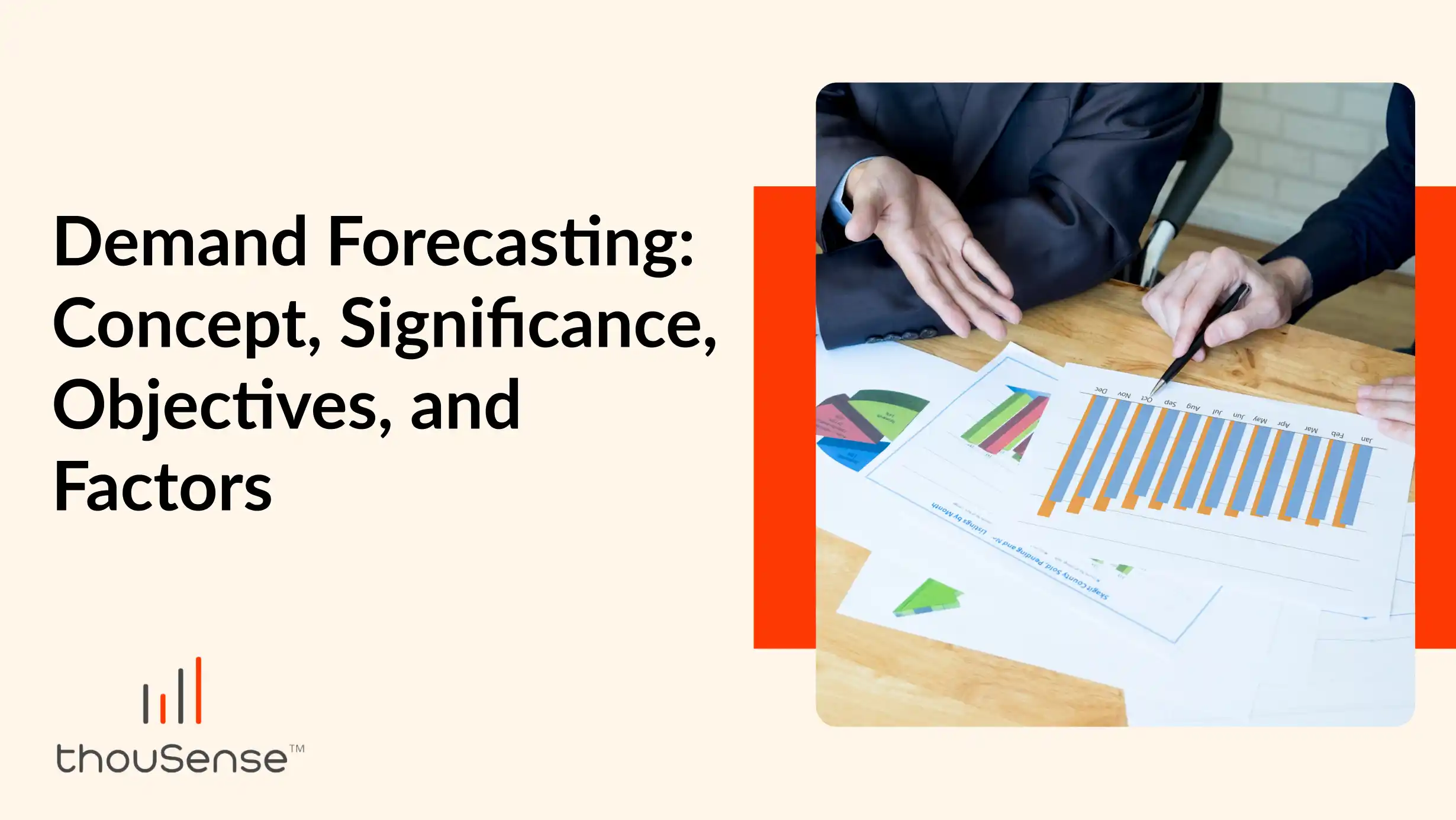
Many internal and external hazards that might have a major influence on an organization's operations are present in the fast-paced business climate of today. Increasing competition, new technology, labor conflicts, inflation, recessions, and regulatory changes are some of these dangers. As a result, risk and uncertainty are major factors in many business choices.
Businesses use demand forecasting to precisely predict future demand for their goods and services to lessen the negative consequences of these risks. Demand forecasting is the systematic technique of estimating an organization's service demand in the face of erratic and conflicting forces.
What is demand forecasting?
Demand forecasting is like predicting what people will want to buy in the future. We accomplish this by examining past purchases and current events in the world. It's similar to predicting what will be in style for the upcoming months.
In simpler words, demand forecasting means collecting information about the market and what people have bought in the past. This aids in future planning, ensuring that they have a sufficient supply of goods to sell, and allocating resources. It's a crucial concept for the efficient operation of enterprises.
Let's look at a straightforward equation to help us better understand the idea of demand forecasting: Assuming that the market circumstances stay the same, we may predict that there will be a demand for 150 units of product Z in April if an organization sold 100, 150, and 200 units in January, February, and March, respectively.
Methods of Demand Forecasting
Demand forecasting methods can be categorized based on the economy and time. Let's explore these methods in detail.
Based on Economy
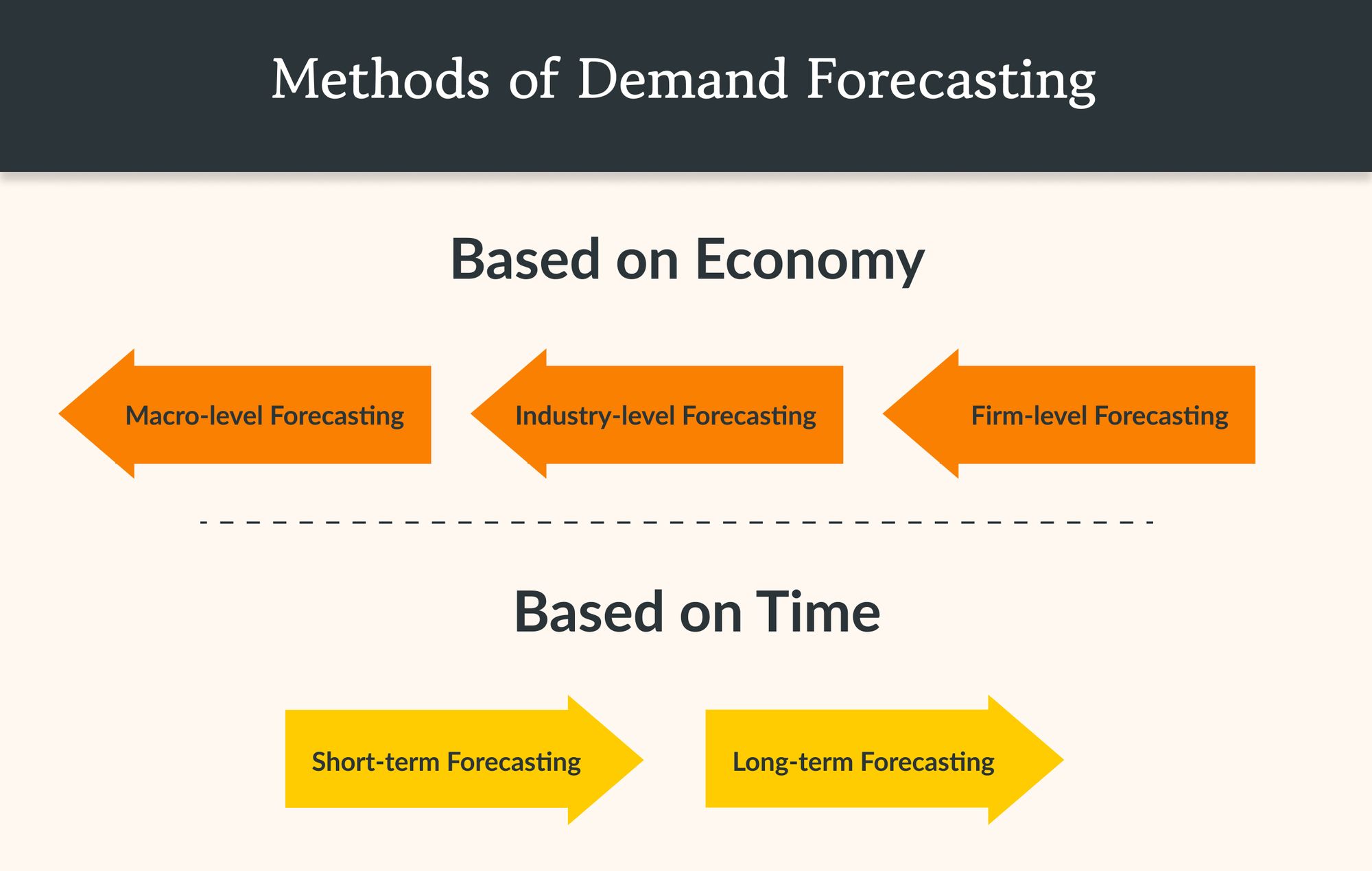
1. Macro-level Forecasting
Macro-level forecasting deals with the economic environment as a whole. It considers factors such as the Index of Industrial Production (IIP), national income, and general employment levels. It provides a broad view of the economic conditions that can influence demand.
2. Industry-level Forecasting
Industry-level forecasting focuses on the demand for an entire industry's products. For example, it may analyze the demand for cement in India or the demand for clothing in India. This approach provides insights into sector-specific demand.
3. Firm-level Forecasting
Firm-level forecasting is more specific and concentrates on forecasting the demand for a particular firm's products. Examples include forecasting the demand for Birla cement or the demand for Raymond clothing. This method helps individual companies make tailored demand forecasts.
Based on Time
1. Short-term Forecasting
Short-term forecasting is typically conducted for a short duration, depending on the industry's nature. It often covers periods of six months or less than a year and is suitable for making tactical decisions.
2. Long-term Forecasting
In general, long-term projections cover periods of two to five years or more. They provide data for major strategic decisions, such as expanding plant capacity or entering new business segments.
Steps Used in Demand Forecasting
The process of demand forecasting involves several essential steps:
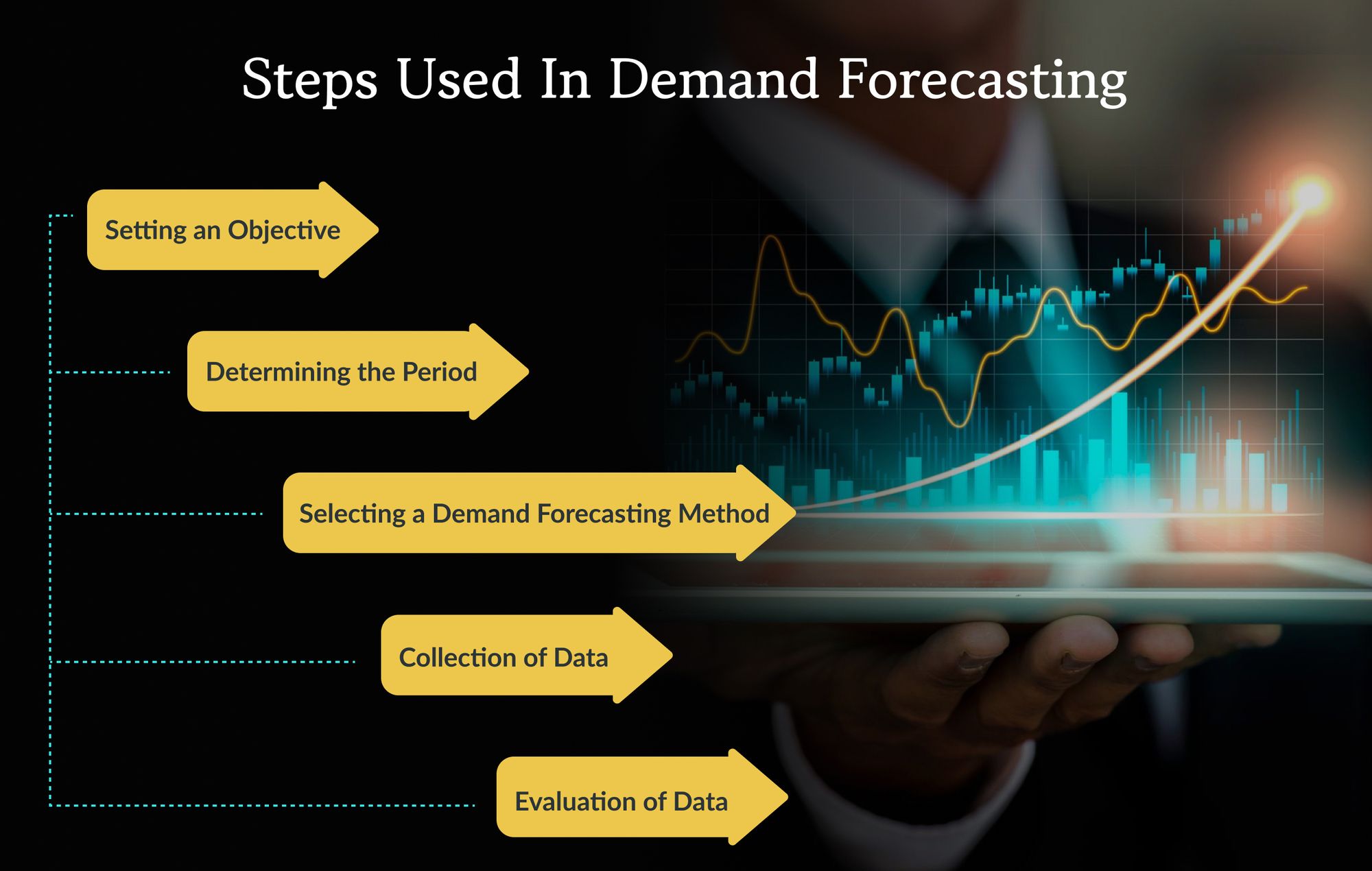
1. Setting an Objective
In the first step, organizations define the purpose of the analysis. They establish clear goals that can be achieved through the analysis, aligning with their specific needs.
2. Determining the Period
Organizations decide whether the analysis will cover a short or long duration. Many forecasts extend over a more extended period as they provide more consistent and reliable data.
3. Selecting a Demand Forecasting Method
The next step involves choosing the most suitable forecasting method, considering factors such as data availability, the nature of the industry, and the forecasting goals.
4. Collection of Data
In this step, organizations collect data according to predefined attributes required for the analysis. This data typically includes historical sales, market conditions, economic indicators, and other relevant variables.
5. Evaluation of Data
In the final step, the collected data is thoroughly evaluated to draw conclusions and make accurate forecasts.
Significance of Demand Forecasting
Demand forecasting holds immense significance for organizations. It allows them to:
● Anticipate Customer Needs: By forecasting future demand, organizations can predict what customers want, enabling them to plan and prepare accordingly.
● Production and Inventory Management: Accurate demand forecasting helps organizations plan production and manage inventory efficiently. It ensures they have the right amount of products on hand to meet customer demand.
● Pricing Strategies: Demand forecasts aid in setting pricing strategies, allowing organizations to optimize their prices based on anticipated demand.
● Marketing and Sales Strategies: Organizations can adjust their marketing and sales efforts based on forecasted demand, improving the effectiveness of their campaigns.
● Cost Reduction: Demand forecasting helps minimize costs associated with overstocking or understocking, reducing the expenses of carrying excess inventory or losing sales due to stock-outs.
● Customer Satisfaction: Meeting demand consistently enhances customer satisfaction, leading to customer loyalty and brand advocacy.
Factors Affecting Demand Forecasting
Several factors can influence the accuracy of demand forecasting. These factors include:
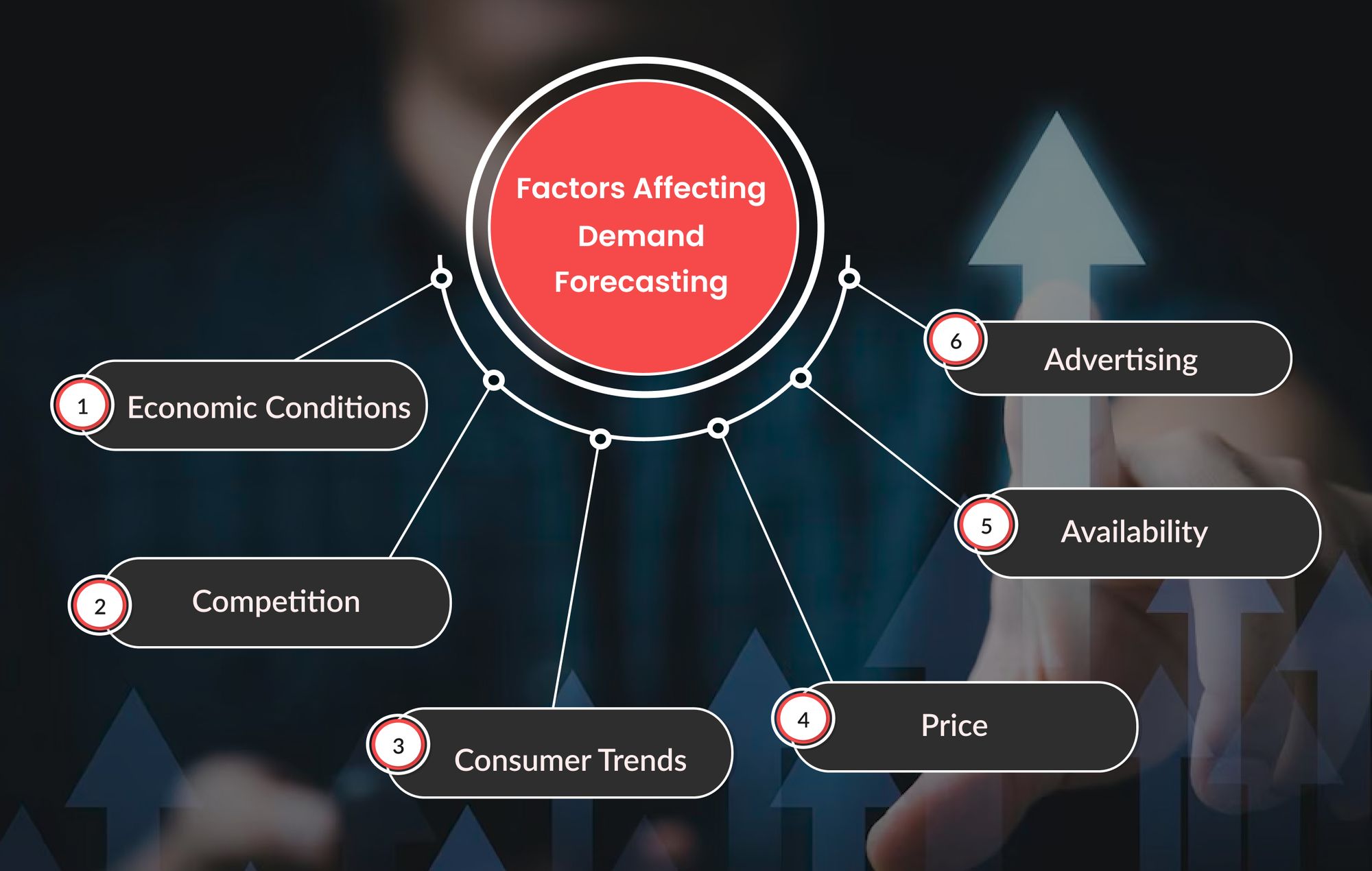
1. Economic Conditions
Economic conditions, such as GDP, unemployment rate, inflation rate, and consumer confidence, play a vital role in shaping the level of demand for products and services. Economic prosperity can lead to increased demand, while economic downturns may reduce it.
2. Competition
The level of competition in a market can significantly impact the demand for a product or service. Intense competition may lead to lower demand for a particular offering.
3. Consumer Trends
Consumer trends have a substantial influence on demand. Changing consumer preferences can lead to fluctuations in demand for certain products or services.
4. Price
Price is a significant factor affecting demand. As prices rise, demand may decrease, and as prices fall, demand may increase.
5. Availability
The availability of a product or service can directly affect its demand. Limited availability or scarcity can drive higher demand, while overabundance can reduce it.
6. Advertising
Advertising and marketing efforts can have a significant impact on demand. Extensive advertising can boost demand for a product or service.
6 Different Types of Demand Forecasting
Demand forecasting relies on a variety of methods, often based on historical sales data. These methods take into account market fluctuations, economic trends, and seasonal variations in demand. Here are six different types of demand forecasting:
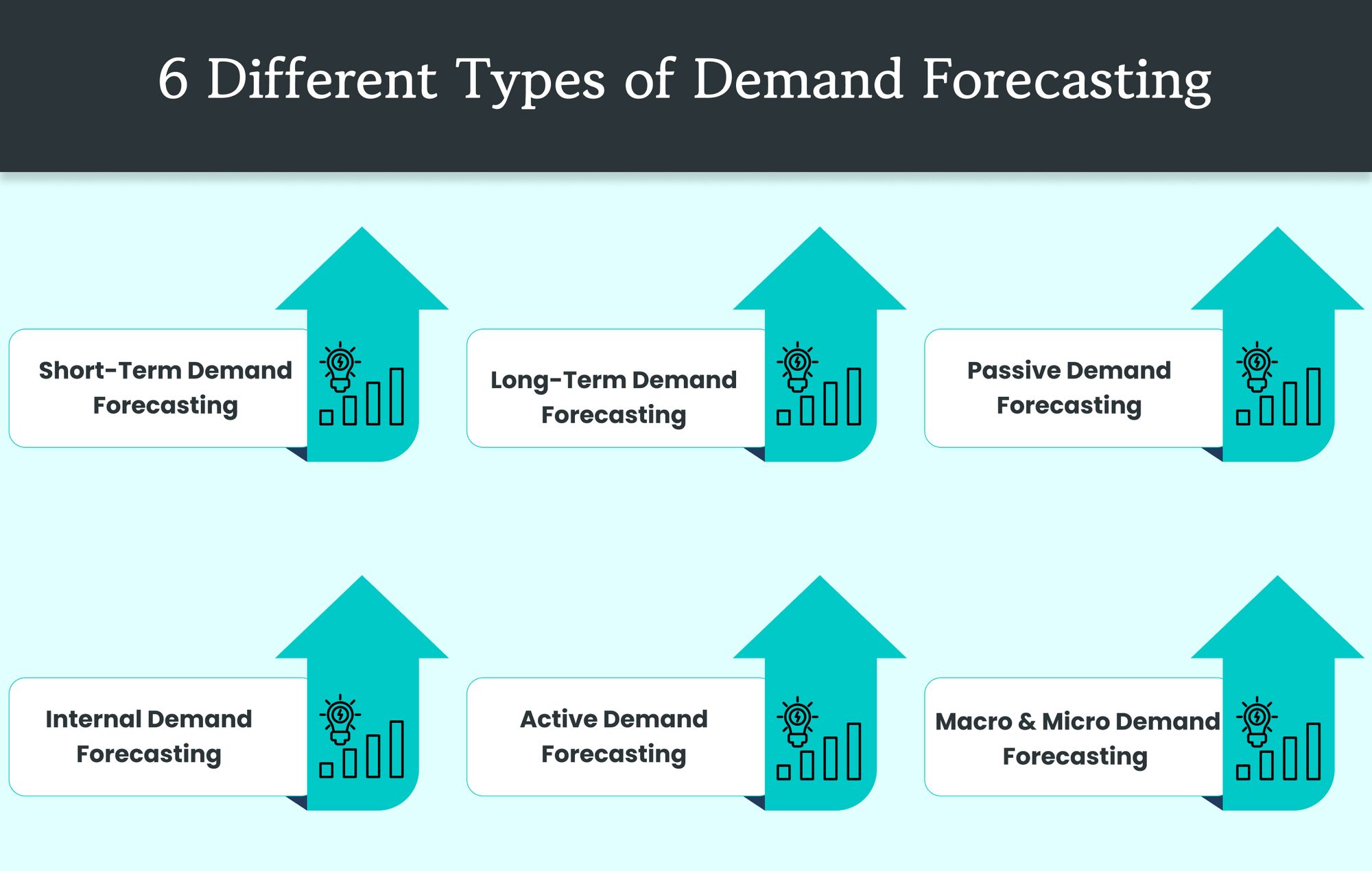
1. Short-Term Demand Forecasting
Short-term demand forecasting focuses on predicting demand for goods and services over a relatively brief period. It is used for making plans for specific time frames, such as the upcoming few weeks or months. This type of forecasting assists businesses in making decisions regarding production, inventory levels, and pricing strategies. Short-term demand forecasting employs methods like statistical analysis, economic modeling, market research, and customer surveys.
2. Long-Term Demand Forecasting
Long-term demand forecasting is like looking into the future to figure out how much people will want to buy for a long time, not just a little while. It's important because it helps companies plan what they need, see where they can do well, and know what might be risky. To make these long-term forecasts, they use different ways like counting and studying the numbers and talking to people about what they might want to buy. This way, they can make good decisions that will last a while.
3. Passive Demand Forecasting
Passive demand forecasting means using only past sales numbers to guess how much people will want to buy in the future. It doesn't think about things like whether it's winter or summer, what people like, or how the economy is doing. This works well for businesses that usually sell about the same amount of stuff and can't easily change when the market does.
4. Internal Demand Forecasting
Internal demand forecasting is about forecasting how much people will want to buy from a company. To achieve this, the business considers a variety of factors, including past sales volume, industry trends, economic conditions, and consumer feedback. This assists the business in determining how much inventory to have on hand to ensure that they have enough for every one of their clients.
5. Active Demand Forecasting
Active demand forecasting is a technique that involves analyzing past consumer behavior and current market conditions to predict future consumer preferences. It's like looking at your past shopping lists and the cool things in stores now to figure out what you might want next.
People use active demand forecasting a lot in stores and factories. It helps them plan what things to make and how much stuff to have in the store. Businesses may make informed decisions regarding what to produce when to place more orders, how much to charge for goods, and how to market their products when they use active demand forecasting.
6. Macro & Micro Demand Forecasting
There are two types of demand forecasting: macro and micro. Macro demand forecasting looks at the big picture - it tries to figure out how much people in the whole country will want to buy. It looks at things like how many people there are, how much money they have, and how much they spend on stuff.
On the other hand, micro-demand forecasting focuses on smaller areas, like cities or towns. It tries to predict what people in a specific place will want to buy. To do this, it looks at things like who lives there, what kind of jobs they have, and what's available to buy in that area.
Micro demand forecasting is super useful for businesses that sell things in one place because it helps them know what their local customers want. This way, they can make sure they have the right stuff in stock, and they can make smart decisions about their business.
8 Important Techniques for Demand Forecasting
Selecting the right technique for demand forecasting is crucial for accurate predictions. Here are eight effective techniques for predicting demand:
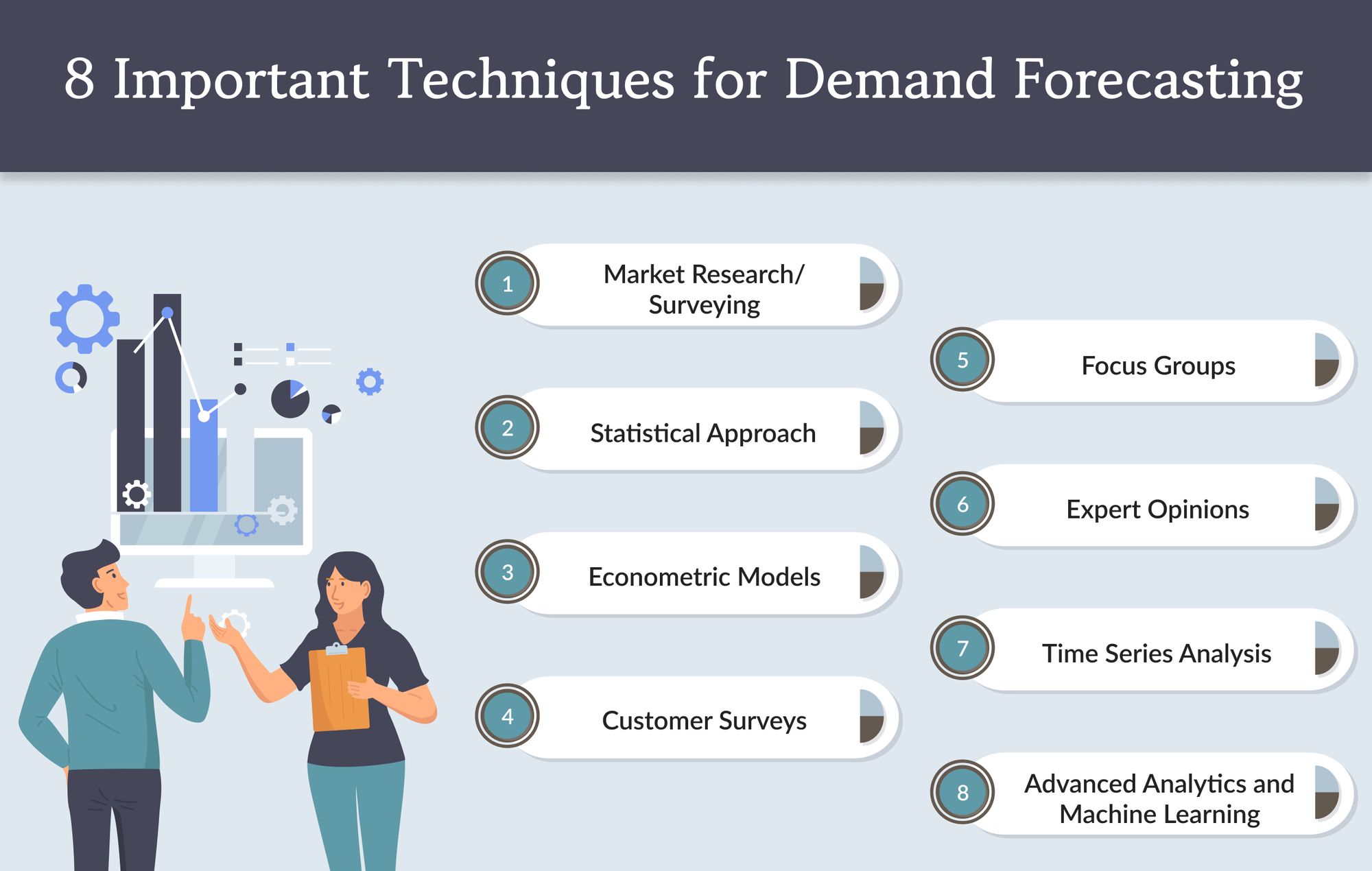
1. Market Research/Surveying
Market research and customer surveys provide valuable insights into consumer preferences and behavior. Online surveys have made it easier to target specific audiences and collect data rapidly. Survey results can inform marketing strategies, uncover opportunities, and enhance understanding of target audience needs.
2. Statistical Approach
Statistical approaches involve using historical data to predict future demand. These methods include trend projection, regression analysis, time series analysis, market segmentation, decision trees, and simulation modeling. Trend projection relies on the study of past data to identify future trends. Regression analysis explores the relationships between demand and external factors. Time series analysis uses historical data to forecast short- and long-term demand. Market segmentation helps identify target market segments, and decision trees analyze variable impacts on demand. Simulation modeling allows for forecasting through scenario analysis.
3. Econometric Models
Econometric models are mathematical models used to describe economic systems and estimate relationships among economic variables. They are vital for forecasting economic trends and examining the effects of economic policies. Econometric models are used to forecast economic behavior and to analyze economic variables' relationships, such as prices, demand, supply, and consumption. These models provide insights into economic trends, potential opportunities, and risks.
4. Customer Surveys
Conducting surveys to gather direct input from customers helps organizations understand their preferences, needs, and future demands. Survey results offer real-time insights into customer behavior, allowing for more accurate demand forecasting.
5. Focus Groups
Focus groups involve small gatherings of potential customers who provide feedback on products or services. This qualitative technique helps organizations understand customer opinions, preferences, and potential demand.
6. Expert Opinions
Seeking expert opinions from industry specialists and market experts can provide valuable insights into future demand trends. Experts can offer unique perspectives and knowledge that inform demand forecasting.
7. Time Series Analysis
Time series analysis uses historical data to forecast future demand based on past trends and patterns. This quantitative method is suitable for short- and long-term demand forecasting and provides reliable data for informed decisions.
8. Advanced Analytics and Machine Learning
Utilizing sophisticated analytics and machine learning methodologies enables enterprises to handle copious volumes of data and adjust to dynamic market circumstances. Machine learning models continuously analyze data, learn from historical demand patterns, and adapt forecasts in real time. These techniques are especially useful for complex industries with extensive datasets, such as e-commerce, manufacturing, and technology.
Bottom Line
In conclusion, demand forecasting is a fundamental practice for organizations, enabling them to anticipate customer needs, optimize production and inventory management, set pricing strategies, and adjust marketing and sales efforts effectively. It minimizes costs related to inventory management, reduces lost sales, and enhances customer satisfaction. The choice of demand forecasting technique depends on an organization's specific needs, industry, and data availability, and selecting the right method is critical for accurate and informed decision-making. Demand forecasting is a dynamic and essential tool that empowers organizations to navigate the complexities of an ever-changing market successfully.
FAQ
Q1. What are the objectives of demand forecasting?
The primary objective of demand forecasting is to predict the demands of goods and services required by a consumer at a particular time. Some other objectives of demand forecasting also include aspects like inventory management, production planning, and supply chain management.
Q2. What is the significance of forecasting in operations management?
The significance of demand forecasting in operations management comes into account while planning or supporting a business to mitigate risks and contingencies for a better revenue generation system. Planning for uncertainties, optimizing business operations, and controlling the budget comes as the significance of forecasting.
Q3. What are the objectives of forecasting in economics?
Objectives of demand forecasting in economics include key factors such as policy decisions and the allocation of resources to different departments. Economics includes a combination of different indicators like inflation and interest rates, businesses can use objectives of forecasting for risk management and strategic planning.
Q4. What is the significance of demand forecasting?
The significance of demand forecasting lies in different areas such as inventory management, production, and financial planning. Businesses can also form their marketing and sale strategies for smooth Supply Chain Management through the support of objectives of demand analysis.
Q5. What is the importance of demand forecasting in e-commerce?
Demand forecasting is the cornerstone of a successful e-commerce business. It makes sure that businesses hold the right product in stock according to the demands of customers. The significance of demand forecasting in e-commerce is that it helps businesses get a competitive edge against other brands.
Q6. What Are the Main Objectives of Demand Forecasting for a Business?
The main objectives of Demand Forecasting for a business include:
- Optimizing Inventory Levels - Ensuring enough stock to meet demand without overstocking.
- Improving Production Planning - Aligning production schedules to anticipated demand, reducing delays.
- Enhancing Financial Planning - Projecting revenue, cash flow, and budgeting more accurately.
- Boosting Customer Satisfaction - Minimizing stockouts and delays, improving customer experience.
- Reducing Costs - Lowering storage, production, and transportation costs by aligning supply with demand.
Accurate demand forecasting supports efficient resource allocation and better customer service.